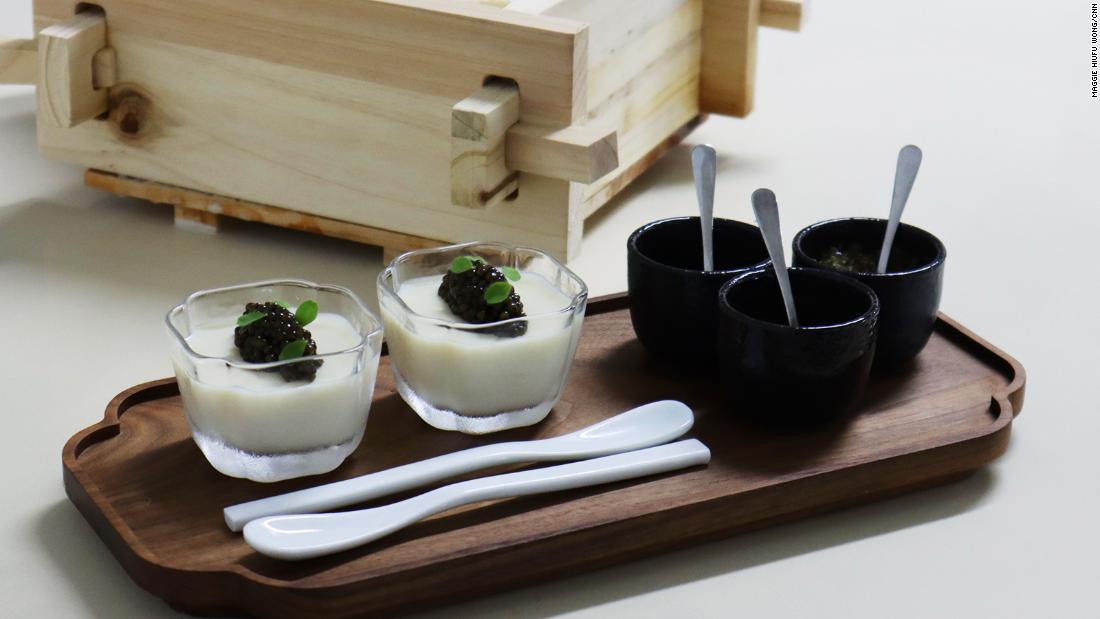“We ordered this machine from Taiwan but they weren’t able to come and set it up due to Covid-19. So it was just me and Romain when we first unboxed and set it up. We didn’t know if things would explode or what would happen,” Lau tells CNN Travel.
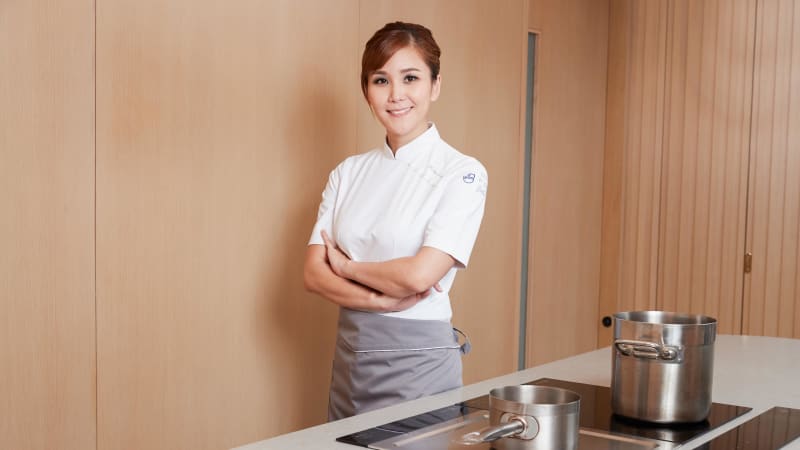
Two-Michelin-starred chef Vicky Lau’s new venture is a soy-themed restaurant.
Courtesy of Mora
Lau says she came up with the concept for Mora while researching recipes for a tasting menu — “Ode to Tofu” — for Tate in 2020.
She fell in love.
“The thing that really stood out about tofu is the texture. I can’t think of another ingredient that has such a wide range of textures, from super-soft silken tofu to super-firm mock meat,” says Lau.
To make the best tofu in town, one has to first produce the best soy milk. That’s where the machine comes in.
Herbreteau, who has become quite the expert on soy milk production, puts the beans — which have been soaked for around 10 hours — into the machine. These will then be ground at a speed of 60 seconds/kilogram and cooked for five to 10 minutes after reaching a temperature of 98 C (208.4 F).
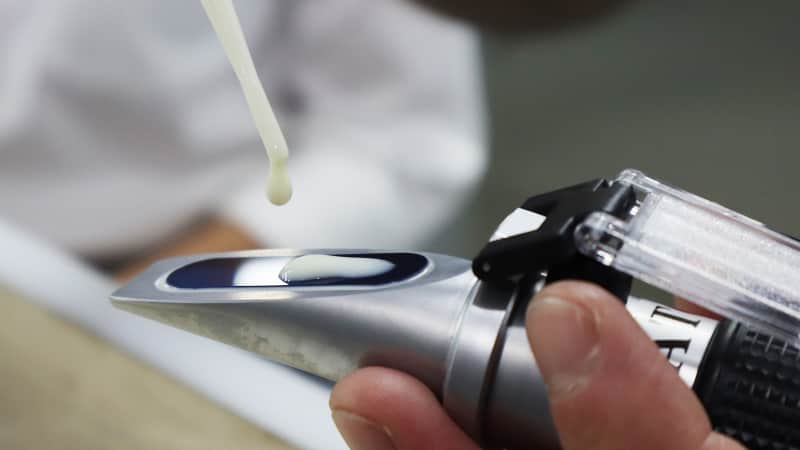
Modern tofu-making: A reflector is used to check the thickness of the soy milk.
Maggie Hiufu Wong/CNN
Over a period of nine minutes, Herbreteau closely observes the flowmeter — a device that measures the speed of the water that passes through. Moments later, the soy milk is extracted and the room fills with the aroma of Japanese-style tonyu — known for having a thicker consistency and a lower water-to-soybean ratio.
“We could immediately feel the difference in the first batch. It’s very creamy and you can really get the bean taste,” says Lau.
Covid-19 fuels rise in popularity of tofu
Lau is not alone in her fascination with soy and tofu.
A food staple in east Asia since its discovery some 2,000 years ago, tofu has become a trendy ingredient in recent years, with demand skyrocketing during the pandemic.

Opening in 2022, Mora has already made it to Michelin’s online guide and there’s a two-month waitlist for those who want to dine there.
Courtesy of Mora
Lau says that the pandemic is also partly responsible for the opening of Mora.
“Mora’s concept came about during Covid-19 because I was pondering who I want to be as a chef. I don’t want to be just a fine dining chef. I want to be one that’s making good in the world as well,” says Lau.
In the last decade, she says she noticed some ingredients had become harder to source.
“It’s really saddening realizing I’m being part of it and wasting a lot of these natural gifts,” says Lau.
“It’s something that we need to think about,” she adds.
With Mora and the factory, Lau says that she is not trying to persuade everyone to become vegetarian — Mora isn’t a vegetarian restaurant — but hopes that by showing people how soy is made and how fresh tofu tastes, people will appreciate it more.
The Mora ethos is about “modernizing a tradition like tofu and educating people to incorporate it in their diet.”
Okutan: A three-century-old tofu restaurant in Kyoto
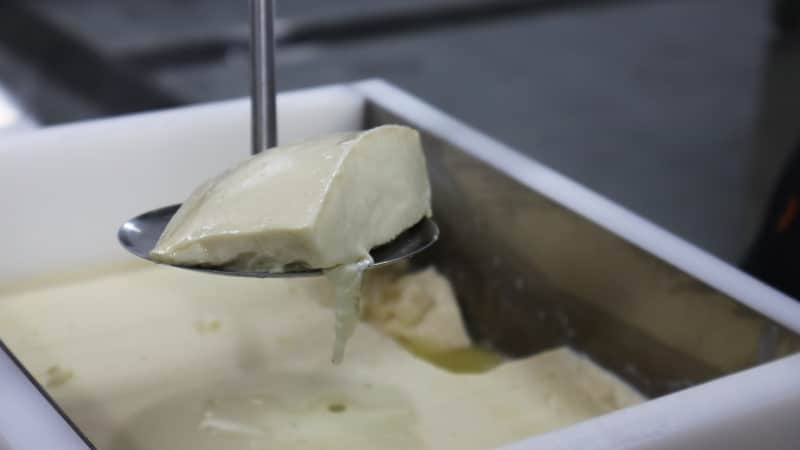
It’s believed that tofu was first discovered 2,000 years ago.
Maggie Hiufu Wong/CNN
Legend has it that tofu was discovered by a health-conscious Chinese prince named Liu An more than 2,000 years ago when he was making an elixir. He realized that soy milk left in certain conditions coagulated and developed a pudding-like consistency — the beginnings of tofu.
Today, the art of traditional tofu-making is well preserved in Kyoto, where restaurants dedicated to temple food and traditional cuisine are still aplenty.
Okutan, founded more than 380 years ago, is one of the oldest tofu restaurants in Kyoto. The ingredient is still made from scratch in the basement, daily.
“When I was young, I had no interest in tofu, and only really liked the dengaku tofu (skewered tofu with a miso glaze) that my grandmother used to make for me,” says 47-year-old Tadasuke Ogura, the 16th-generation owner of Okutan Kiyomizu. “After my father asked me to help, I became interested in the depth of tofu.”
Ogura left his own business to devote more time to his family’s restaurant when he was in his 30s.
Mukashi-tofu, or “olden days” tofu, is the restaurant’s signature set.
It begins with goma tofu — a cold sesame tofu pudding — and dengaku tofu. It’s then followed by the famous yutofu — cubes of tofu boiled in dashi broth.
“Mukashi-tofu is made entirely by hand. You cannot make the tofu, even if you have learnt the process. You need to accumulate a wealth of experience and cultivate your senses by seeing tofu with your eyes and touching it with your hands,” says Ogura.
Straws layered with coarse seasalt are hung around the humid basement. The salt produces a natural seawater solution due to the humidity.
This is collected and adjusted to a concentrated level — “that is our secret” — to produce the shop’s own coagulant, which is added to the freshly extracted soy milk to make tofu.
He believes making it this way helps Okutan stand out from other tofu places in Kyoto.
Tofu travels the world: Ben Franklin and a Chinese spy
While East Asia has been munching on tofu for more than 1,000 years, it took a lot longer for it to catch on globally.
Benjamin Franklin, one of the United States’ founding fathers, wrote a letter while he was in London — with some soy beans attached — raving about a “Chinese cheese” in 1770. It was one of the earliest documents on record mentioning tofu in the West.
Li Shizeng, a spy-turned-tofu enthusiast and political activist, is often credited with making tofu a more widely accepted food outside of Asia.
It’s said he was first sent by the Chinese government to attend a French military school as a spy. He ended up studying at the agricultural school in Montargis and developed a passion for promoting tofu in France.
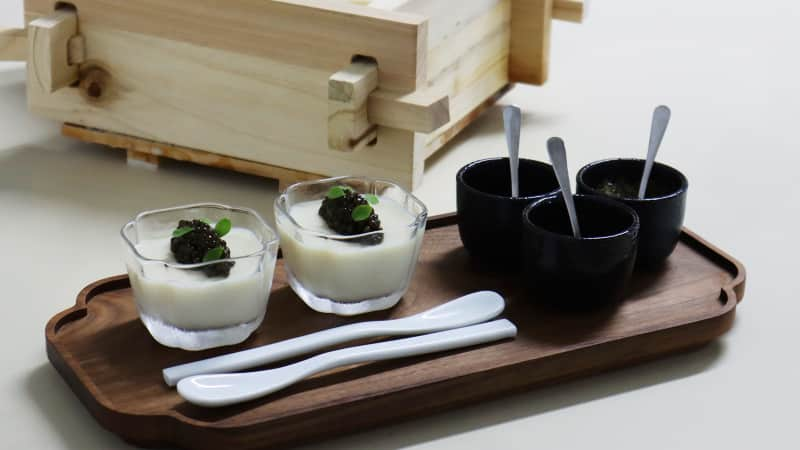
Mora’s silken tofu dish.
Maggie Hiufu Wong/CNN
He built a tofu factory in Paris in 1908, applied for the world’s first soy milk patents, wrote books and hosted a fancy tofu-themed luncheon — naming the dishes soy cheese and vegetarian ham.
Shurtleff and Aoyagi’s “The Book of Tofu” and Frances Moore Lappé’s “Diet for a Small Planet,” both published in the 1970s, are also credited with promoting the ingredient to the Western masses.
Debunking myths about tofu
Few people in the US are as obsessed with tofu as Mark Messina, a doctor who was also introduced to the ingredient in the 1970s.
“My martial arts instructor said my skills would improve if I became a vegetarian,” he says.
His sister prepared scrambled tofu for him — a popular dish made with firm tofu and turmeric powder. He loved it and it became a mainstay in his diet.
His professional interest in tofu didn’t begin until 1989 when he was program director at the National Cancer Institute’s (NCI’s) Diet and Cancer Branch.
Messina was responsible for identifying promising research areas when he received a note inquiring about the correlation between soybeans and breast cancer prevention.
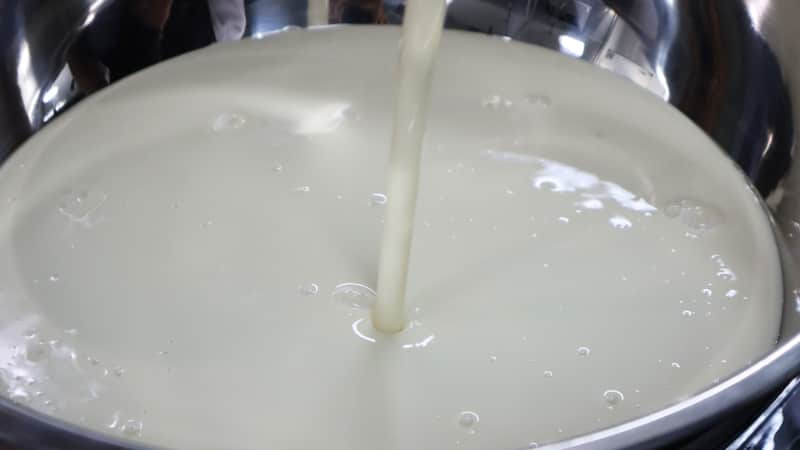
Mora produces Japanese-style soy milk — it’s thicker and creamier — for its tofu.
Maggie Hiufu Wong/CNN
“An administrative assistant showed me this note because she knew I ate tofu,” Messina tells CNN Travel.
Within a few months, he organized a workshop on the role of soy in cancer prevention and treatment and published the findings.
“As I learned more about soy, I became interested in its potential benefits beyond cancer. Consequently, I left the NCI in 1992 to devote all of my time to studying soy. I didn’t have a job when I left, so in retrospect that is one foolish decision that worked out,” says Messina.
He is now the director of nutrition science and research at the Soy Nutrition Institute, a non-profit corporation with a mix of members — including large food brands, scientists and soybean farmers — that aims to promote soy-based foods.
Messina said there are still many myths about soy products, like that tofu increases the risk of breast cancer.
He said that today’s clinical research has shown otherwise.
“The scientific consensus has changed dramatically as the research has evolved. While in the 1990s animal research suggested soy could be harmful to women with a history of breast cancer, today’s human research — which is obviously much more meaningful — suggests it could be beneficial,” says Messina.
He recommends an intake of half a cup of tofu and soy products two to three times per week, especially for young girls.
“(Tofu is) inexpensive and incredibly versatile and widely available. Besides protein, it can be a good source of calcium and is rich in isoflavones,” Messina says.
“Although I am not equipped to forecast trends, there is no doubt that increasing numbers of Americans know what tofu is and have tried it. Certainly, the recent emphasis on consuming more plant protein shines a spotlight on foods like tofu … I think as people enjoy the new generation of soy burgers, they will be more likely to try the traditional soy foods.”
Tofu as a modern fine-dining item
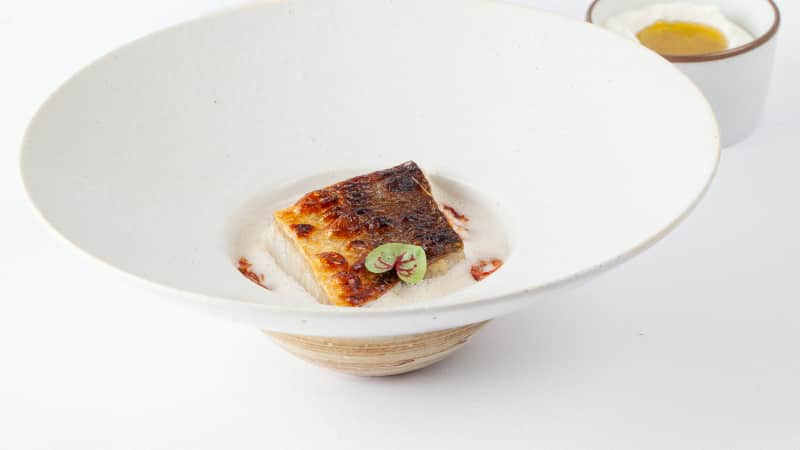
Mora’s one-sided crispy threadfin with savory soy milk.
Courtesy of Mora
At Mora, tofu is served in a modern way.
“It’s a different way of thinking of tofu,” Lau says.
The tasting menu is designed around textures. The dishes and ingredients change according to the seasons.
The current menu starts with the texture “Silken,” represented by a housemade velvet tofu paired with condiments like century egg and caviar and slippery cold noodles in chicken and soy milk broth,
Then it is followed by “Crisp,” (crispy tofu sheet salad), “Jade” (crispy chicken marinated in red tofu), “Dew” (a tofu stew) and “Ice” (a tofu crème brulée with soy sauce).
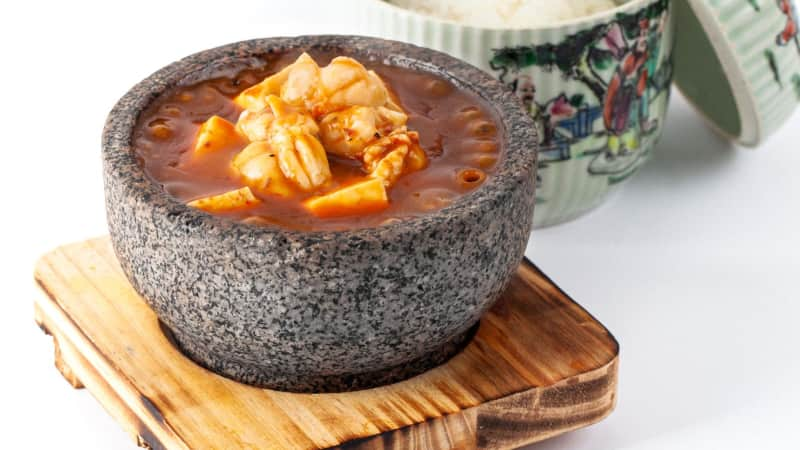
Lau hopes she can inspire people to incorporate more soy foods into their daily diets.
Courtesy of Mora
“A lot of people think of tofu as a sick people food and think it is quite bland,” says Lau. “But it can be incorporated anywhere.
“When I think of a dish, it’s not just the protein itself — it is also about how you marinate it, what texture and temperature it is. There are many factors at play. We hope we’ll open up more minds to enjoy tofu protein in different ways.”
Mora’s stew of the day, for example, is a mapo tofu-inspired dish featuring lobsters and two types of tofu — silken tofu and frozen tofu.
“Frozen tofu is made by soaking normal tofu in water then freezing it. When it is defrosted, the water crystals in the holes evaporate. Then the tofu becomes a honeycomb-like sponge that absorbs all the flavor,” says Lau.
She is already dreaming about what to create next.
Top photo: Soy beans are used to create soy milk, from which tofu is made. Credit: Maggie Hiufu Wong/CNN
CNN’s Junko Ogura and Yuki Kurihara contributed to this feature.
